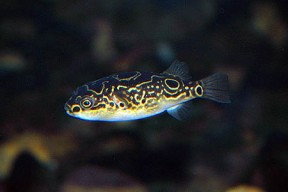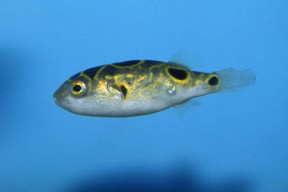Tetraodon biocellatus
Figure Eight Puffer
Classification
Tetraodontidae
Distribution
Cambodia, Malaysia, Indonesia.
Habitat
Inhabits rivers and coastal waters. It’s found most often in freshwater, but also occurs frequently in brackish conditions.
Maximum Standard Length
3.2″ (8.0cm).
Aquarium SizeTop ↑
30″ x 12″ x 12″ (75cm x 12cm x 12cm) – 70 litres.
Maintenance
Best kept in a heavily-planted setup with twisted roots and branches to provide additional cover, although soft-leaved plants may be chewed by the fish. Leave some open spaces inbetween for swimming, as this is an active species. The use of a sandy substrate and floating plants to diffuse the light is also recommended. This species is very sensitive to deteriorating water conditions, so regular partial water changes are a must. Although it’s often considered a true freshwater species, it tends to be more long-lived with the addition of marine salt to a sg of around 1.005 in aquaria. It can also be maintained in freshwater, however.
Water Conditions
Temperature: 72-79°F (22-26°C)
pH: 6.5-7.5
Hardness: 5-12°H
Diet
Relishes all kinds of shellfish, as well as worms and other live and frozen foods. It should be fed snails and unshelled shellfish (such as crab legs, prawns etc.) regularly, in order to maintain its sharp teeth. As with other puffers, these grow continuously and become a problem for the fish if they’re not kept ground down.
Behaviour and CompatibilityTop ↑
Can be kept in a community tank, but caution should be exercised when choosing tankmates, as it tends to nip the fins of slow-moving or long-finned fish. In freshwater, it does well with fast-moving species such as characins, rasboras and barbs. In a brackish community tankmates can include monos, bumblebee gobies and salt-tolerant Chanda species.
Although it will live in the company of conspecifics in a suitably large tank, studies have shown that specimens kept singly usually live much longer in captivity. If you want to keep more than one, try to buy at least four fish, so that any aggression is dissipated between the group.
Sexual Dimorphism
Almost impossible to sex by external means. Adult females may grow larger than males.
Reproduction
Not thought to have been bred in the hobby. Apparently, it’s a substrate spawner and the male exhibits some degree of brood care.
NotesTop ↑
Puffer fish are so called as they have the ability to inflate their elastic stomachs with water or air. This is usually a response to some kind of threat, although in the aquarium many specimens appear to inflate themselves for no apparent reason. The fish becomes 2 or 3 times its normal size, big enough to scare away many potential predators, or difficult to swallow.
Puffers also have several other interesting adaptations. They are one of the few fish that can actually blink or close their eyes, which only serves to add further charm to what is already a fish with bags of character. They also have beak-like mouthparts, which are formed by a fusing of 2 teeth from each jaw (hence Tetraodon). These are used to crush shelled invertebrates, the favourite food of most puffers.
Many parts of the body of puffers contain the deadly neurotoxin tetrodoxin. This is the same poison found in the notorious blue-ringed octopus. When ingested in sufficient quantities, it can cause paralysis and death. As yet, there is no known antitoxin and to humans it is over 1000 times deadlier than cyanide. Grotesquely, the victim usually remains conscious as he or she becomes paralysed. It’s a famous delicacy in Japan, but is prepared only by highly-trained chefs, and even then many people have died from eating it. This need not worry you, but if you need to get rid of your puffer, sell it on: getting the barbecue out is not recommended!
T. ocellatus is one of the more commonly seen puffers in the trade, but is not really suitable for the general aquarist due to its dietary requirements and need for very high quality water. When kept correctly it’s a charming little fish that can show real personality.


